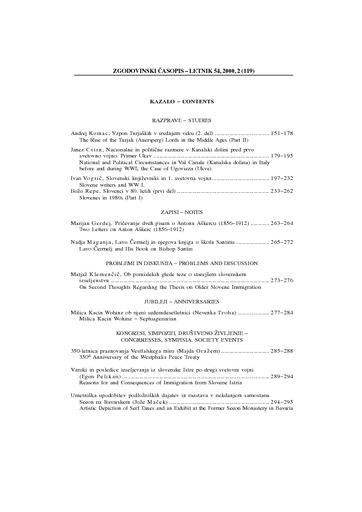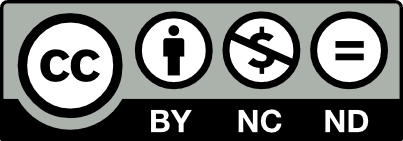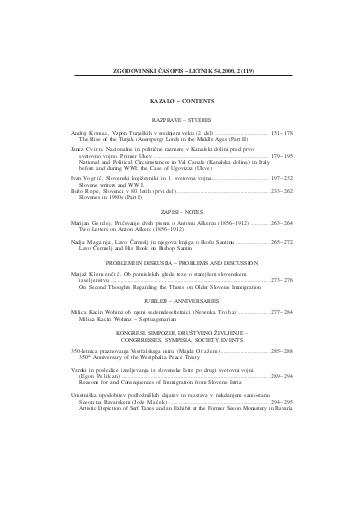/
Periodicals
/
Zgodovinski časopis
Slovenes in 1980s (Part I)

Author(s):Božo Repe
Co-author(s):Peter Štih (odg. ur.)
Year:2000
Publisher(s):Zveza zgodovinskih društev Slovenije, Ljubljana
Source(s):Zgodovinski časopis, 2000, št. 2
Language(s):slovenščina
Type(s) of material:text
Keywords:slovenska zgodovina, sodobna zgodovina, razpad Jugoslavije, večstrankarski sistem, osamosvojitev, Slovenes, multiparty system, independence
Rights:

This work by Božo Repe is licensed under Creative Commons Attribution-NonCommercial-NoDerivs 4.0 International
Files (1)

Name:ZC_2_-_2000.pdf
Size:928.98KB
Format:application/pdf
Permanent link:https://hdl.handle.net/11686/file49
Description
The article deals with political and economic processes taking place in Slovenia and in
Yugoslavia after President Tito’s death in 1980 until the 1990 plebiscite proclaiming an
independent Slovenia. 1980’s denoted a turning point in recent Slovene history, leading
to the introduction of a multyparty sistem and the secession from Yugoslavia. The author
describes and analyzes the appearance of informal, and later formal, opposition, civil
society activities, relationship between Slovene authorities and the opposition, formation
of national programs and the search for consensus between different political fractions,
the process of secession from Yugoslavia and subsequent independence (economic,
constitutional/legal, military, international), and the relations between Slovenia and the
Federal Republic of Yugoslavia.
Metadata (12)
- identifierhttps://hdl.handle.net/11686/5438
- title
- Slovenci v osemdesetih letih (1. del)
- Slovenes in 1980s (Part I)
- creator
- Božo Repe
- contributor
- Peter Štih (odg. ur.)
- subject
- slovenska zgodovina
- sodobna zgodovina
- razpad Jugoslavije
- večstrankarski sistem
- osamosvojitev
- Slovenes
- multiparty system
- independence
- description
- The article deals with political and economic processes taking place in Slovenia and in Yugoslavia after President Tito’s death in 1980 until the 1990 plebiscite proclaiming an independent Slovenia. 1980’s denoted a turning point in recent Slovene history, leading to the introduction of a multyparty sistem and the secession from Yugoslavia. The author describes and analyzes the appearance of informal, and later formal, opposition, civil society activities, relationship between Slovene authorities and the opposition, formation of national programs and the search for consensus between different political fractions, the process of secession from Yugoslavia and subsequent independence (economic, constitutional/legal, military, international), and the relations between Slovenia and the Federal Republic of Yugoslavia.
- Avtor v članku obravnava politične in ekonomske procese, ki so se v Sloveniji in Jugoslaviji dogajali od Titove smrti (1980) do plebiscita o samostojnosti in neodvisnosti Slovenije. Osemdeseta leta so bila eno od prelomnih obdobij v novejši slovenski zgodovini in so na koncu pripeljala do uvedbe večstrankarskega sistema in osamosvojitve Slovenije. Opisani in analizirani so: nastanek najprej neformalne, potem pa tudi formalne opozicije, delovanje civilne družbe, odnosi med oblastjo in opozicijo v Sloveniji, nastajanje nacionalnih programov in iskanje konsenza med političnimi silami v Sloveniji, proces osamosvajanja na posameznih področjih (gospodarskem, ustavnopravnem, vojaškem, mednarodnem) in odnosi med Slovenijo in federacijo v tem obdobju v celoti.
- publisher
- Zveza zgodovinskih društev Slovenije
- date
- 2000
- type
- besedilo
- language
- Slovenščina
- isPartOf
- rights
- license: ccByNcNd
Citirano v (1)
| Tipologija | Avtor(ji) | Naslov | Kraj | Založba | Leto |
|---|---|---|---|---|---|
| 2.01 Znanstvena monografija | Piškurić, Jelka | "Bili nekoč so lepi časi" : vsakdanjik v Ljubljani in okolici v času socializma | Ljubljana | Inštitut za novejšo zgodovino ; Študijski center za narodno spravo | 2019 |
